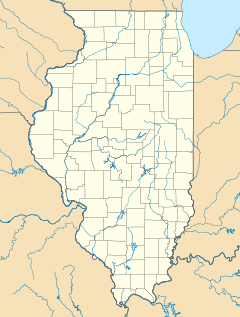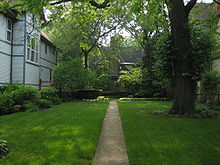- Charles E. Roberts Stable
-
Charles E. Roberts Stable
 The Roberts Stable's rear elevation, viewed from a public alleyway.
The Roberts Stable's rear elevation, viewed from a public alleyway.Location: Oak Park, Cook County, Illinois, USA Coordinates: 41°53′32″N 87°47′36″W / 41.89222°N 87.79333°WCoordinates: 41°53′32″N 87°47′36″W / 41.89222°N 87.79333°W Built: 1896[1] Architect: Frank Lloyd Wright (remodel)
Charles E. White (residential conversion)Architectural style: Tudor Revival Governing body: Private owner Part of: Frank Lloyd Wright-Prairie School of Architecture Historic District (#73000699) Added to NRHP: December 4, 1973 The Charles E. Roberts Stable is a renovated former barn in the Chicago suburb of Oak Park, Illinois, United States. The building has a long history of remodeling work including an 1896 transformation by famous American architect Frank Lloyd Wright. The stable remodel was commissioned by Charles E. Roberts, a patron of Wright's work, the same year Wright worked on an interior remodel of Roberts' House. The building was eventually converted into a residence by Charles E. White, Jr., a Wright-associated architect, sources vary as to when this occurred but the house was moved from its original location to its present site in 1929. The home is cast in the Tudor Revival style but still displays the architectural thumb print of Wright's later work. The building is listed as a contributing property to a federally designated U.S. Registered Historic District.
Contents
History
Charles E. Roberts was an engineer, inventor and an important early client of Frank Lloyd Wright.[2] Roberts was an influential member of the building committee of Unity Temple in Oak Park.[3] For Roberts, Wright also developed the Quadruple Block Plan of 1900-1903.[4] Many architectural historians have mistakenly identified Charles E. Roberts as the father of Oak Park Studio architect Isabel Roberts.[5] As has been well documented, Isabel's father was James H. Roberts of South Bend, Indiana.
In 1896 Charles E. Roberts, an established patron of Frank Lloyd Wright, commissioned two jobs by the architect. One was the Charles E. Roberts House, which Wright executed an interior remodel on and the other was the Charles E. Roberts Stable.[6] Wright redesigned the structure from an old barn into a garage for Roberts' electric car.[7] The building was eventually converted into a residence by architect Charles E. White, Jr., Roberts' son-in-law and an employee in Wright's studio in the years 1903-1905. Sources greatly vary on the date of White's conversion.[6][7] The village of Oak Park's landmark nomination form for Wright's other Roberts project, the patron's home, puts White's conversion of the garage into a residence at in 1929, at the same time the structure was physically moved from its original location to its present location.[6] Historian Thomas O'Gorman, while noting the 1929 move, stated that the Wright-redesigned barn conversion was altered into a dwelling between 1903 and 1904. O'Gorman connects White's remodel to the sheer overhaul the building experienced under Wright's creative thumb.[7]
Architecture
The house elicits in its a viewer a distinct "English feel."[7] Indeed, through its many remodelings the building is cast in the Tudor Revival style of architecture.[6] The structure displays a steeply pitched, side gabled roof, rounded bay and half-timbering, all common elements of the Tudor Revival style.[6] Other 1890s Wright designed buildings also displayed a connection to the traditional domestic architecture styles. The house has a vertical upsweep which projects a sense of shelter and safety associated with Wright's broad, overhanging eaves found in Wright's roof designs. White carried Wright's design a step further in his remodel but Wright's architectural skill is still evident in the structure.[7]
The home expresses a familial coziness, common to Wright's later early modern Prairie homes. The entire idea of barn conversion, in the late 19th century, was an architectural leap forward.[7] Wright's work on the stable introduced angularity and converted it from a barn to a building which expressed a meld of country charm and modernity. O'Gorman compared the home to those designed by architect Edward Luytens. The prominent roof features second-story dormers and its massive scale is balanced by Wright's placement of towering chimneys at either end of the house.[7] The home's front facade is obscured by bushes, trees and landscaping during the warmer months and the home is best viewed in autumn or winter.[8]
Significance
The Charles E. Roberts Stable is one of several examples of Wright's work on pre-existing structures found in the village of Oak Park. Other examples include the Peter A. Beachy House and the Hills-DeCaro House, as well as the Roberts House; each of those buildings were pre-existing homes.[9] The building once sat at the rear of the Charles E. Roberts House, a locally designated Oak Park Landmark, today it stands next door to that structure.[8] The stable is listed as a contributing property to the Frank Lloyd Wright-Prairie School of Architecture Historic District.[10] The historic district was listed on the U.S. National Register of Historic Places on December 4, 1973.[11]
References
- McAlester, Virginia & Lee. A Field Guide to American Houses, Alfred A. Knopf, Inc, New York: 1984, pp. 355–71, (ISBN 0394739698).
Notes
- ^ Frank Lloyd Wright Architectural Guide Map, Frank Lloyd Wright Preservation Trust.
- ^ Frank Lloyd Wright: An Autobiography, by Frank Lloyd Wright, p. 383
- ^ Frank Lloyd Wright: An Autobiography, by Frank Lloyd Wright, pp. 153, 158
- ^ Frank Lloyd Wright and His Vision of the Future, by Franz Sdoutz
- ^ The Architecture of Frank Lloyd Wright, by William Allin Storer, Second Edition, p. 150
- ^ a b c d e "Charles E Roberts House," (PDF), Oak Park Landmark Nomination Form, HAARGIS Database, Illinois Historic Preservation Agency. Retrieved 14 June 2007.
- ^ a b c d e f g O'Gorman, Thomas J. Frank Lloyd Wright's Chicago, Thunder Bay Press, San Diego: 2004, pp. 100-103, (ISBN 1592231276).
- ^ a b "Charles E. Roberts Stable House," Oak Park Tourist, excerpted from: Sprague, Paul E. Guide to Frank Lloyd Wright & Prarire School Architecture in Oak Park Oak Park Bicentennial Commission of the American Revolution [and] Oak Park Landmarks Commission, Village of Oak Park: 1986, (ISBN 0961691506). Retrieved 14 June 2007.
- ^ "Hills-DeCaro House," (PDF), Oak Park Landmark Nomination Form, HAARGIS Database, Illinois Historic Preservation Agency. Retrieved 14 June 2007.
- ^ "Frank Lloyd Wright-Prairie School of Architecture Historic District," Property Information Report, HAARGIS Database, Illinois Historic Preservation Agency. Retrieved 14 June 2007.
- ^ National Register Information System[dead link], National Register of Historic Places, National Park Service. Retrieved 14 June 2007.
Categories:- NRHP articles with dead external links
- Historic district contributing properties
- Frank Lloyd Wright buildings
- Frank Lloyd Wright Prairie School of Architecture Historic District
Wikimedia Foundation. 2010.


